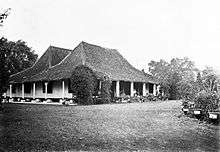Cianjur, Cianjur Regency
Cianjur (Sundanese: ᮎᮤᮃᮔ᮪ᮏᮥᮁ) is a town and district in the West Java province of Indonesia, and is the capital of Cianjur Regency. The district of Cianjur is located along one of the main roads between Jakarta (120 km to the northwest) and Bandung (60 km to the east). The population was 164,511 at the 2018 Census.[1] Because of its location, some of Cianjur's residents commute to work either in Bandung or in Jakarta.
Cianjur ᮎᮤᮃᮔ᮪ᮏᮥᮁ | |
|---|---|
Main road in Cianjur | |
| Coordinates: 6°49′12″S 107°8′27″E | |
| Country | |
| Province | West Java |
| Regency | Cianjur Regency |
| Inception | 1677 |
| Government | |
| • Camat | Yudi Suhartoyo |
| • Secretary | Kuntjara Sobandi Sachri |
| Area | |
| • Total | 24.51 km2 (9.46 sq mi) |
| Elevation | 392 m (1,286 ft) |
| Population (2018)[1] | |
| • Total | 164,511 |
| • Density | 6,700/km2 (17,000/sq mi) |
| Time zone | UTC+7 (IWT) |
| Website | Official website |


The road on which Cianjur is located used to be the main (extremely busy) road from Jakarta to Bandung but was in effect replaced as the main road link between these two main cities when the Jakarta-Bandung tollroad was fully completed in 2005. However, due to its low traffic, Cianjur return as one of alternative routes for travellers from Jakarta and Bandung.[2][3]
History
Cianjur was founded in 1677, with the first head of the town being R. A. Wiratanudatar I, entitled Dalem Cikundul, as the descendant from the old Sundanese kingdom of Pajajaran.[4]
More than 75 people were killed in the earthquake of 2 September 2009.[5]
Administrative divisions
Cianjur district is divided into 11 administrative villages which are as follows:[1]
- Babakankaret
- Bojongherang
- Limbangansari
- Mekarsari
- Muka
- Nagrak
- Pamoyanan
- Sawahgede
- Sayang
- Solokpandan
- Sukamaju
Economy
The district mainly produces home and micro Industrial products, especially leather, wood, precious metals, woven, pottery, fabrics, and foods.[1]
Transportation
After being dormant for about 2 years, the train called Siliwangi between Sukabumi and Cianjur was reactivated on 8 February 2014. It is faster than the buses which are usually trapped in traffic jams, but the cost of a train ticket is double that of using buses.[6]
Policies
By 2007 the city government asked female municipal employees to wear jilbab (hijab). It also placed road signs encouraging women to wear jilbab.[7]
References
- Cianjur District in Figures 2018
- "Tol Cipularang Sudah Enggak Asyik, Jakarta-Bandung Bisa 6 Jam, Dishub Sarankan Naik Kereta Api – Tribun Jabar". Tribun Jabar (in Indonesian). 7 April 2018. Retrieved 3 November 2018.
- "Jalur Bogor-Bandung via Cianjur Diusulkan jadi Jalan Wisata". SINDOnews.com (in Indonesian). Retrieved 3 November 2018.
- "Dalem Cikundul, Murid Sunan Gunung Jati Penyebar Islam di Cianjur - Tribunnews.com". Tribunnews.com (in Indonesian). 29 May 2017. Retrieved 3 November 2018.
- "Evakuasi Korban Gempa di Cianjur Sampai 10 September". Tempo (in Indonesian). 8 September 2009. Retrieved 3 November 2018.
- "Humas: Tarif KA Cianjur-Sukabumi Masih Bisa Dikoreksi". 8 February 2014.
- Warburton, Eve (January–March 2007). "No longer a choice" (89 ed.). Inside Indonesia. Retrieved 20 June 2017.